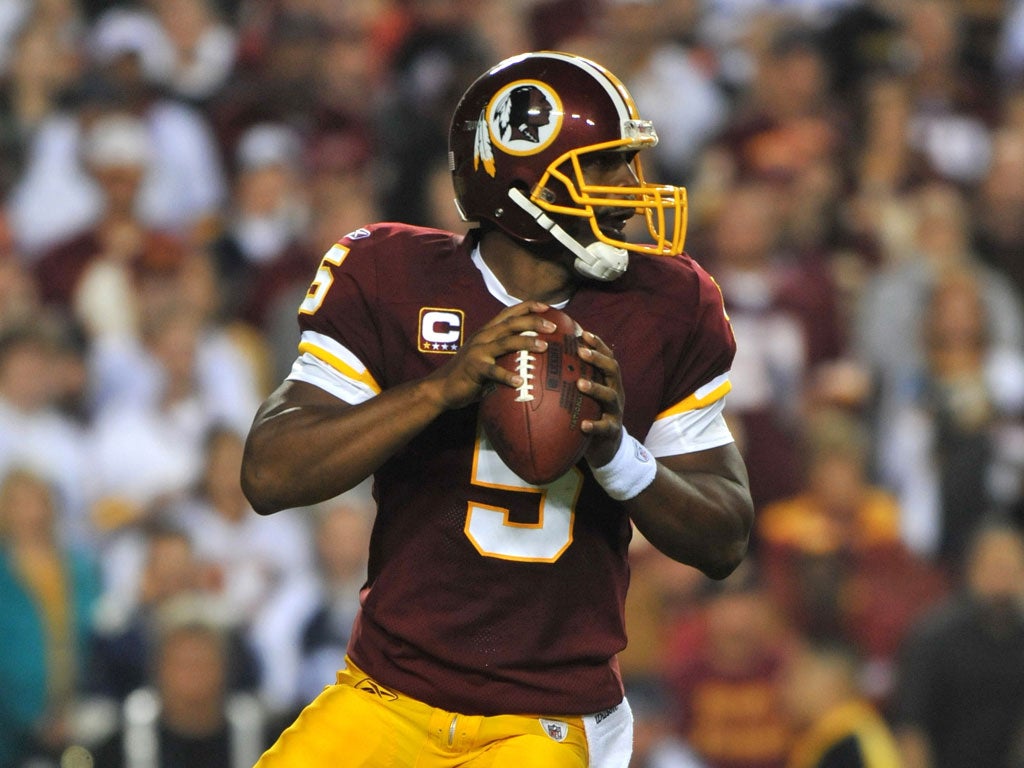Rupert Cornwell: Washington's long road to racial harmony on the football pitch
Out of America: The Redskins team is the one thing that unites a divided capital. But the side's history is a very chequered one


Washington DC is a place of stark contrasts: between Republicans and Democrats, of course, and between the traditionally segregated neighbourhoods where whites and the blacks who make up the majority of the population live out lives that barely intersect, even between its seasons, of sweltering summers and biting cold winters.
With his trademark wry wit, John F Kennedy once described the city as "combining northern charm and southern efficiency". Half a century on, you can still see what he meant. Washington may be shorthand for a superpower, but deep down it retains the rhythms of Dixie. About one institution at least, however, the entire city has been in accord. That institution is its football team, the Washington Redskins.
Today Americans take racial equality at the summit of professional sport for granted. Ice hockey may still be virtually whites only, but of the other major leagues, baseball is a rainbow mix, while 65 per cent of National Football League players are black, as are no less than 82 per cent of National Basketball Association players.
Indeed, without black athletes whose appeal crossed racial lines – from Jackie Robinson, the first African-American to break baseball's colour barrier in 1947, to Muhammad Ali, Michael Jordan and Tiger Woods – Barack Obama might well never have been elected president. If black athletes (and black entertainers) could become national heroes, then why not a black politician?
Even so, black coaches not so long ago were unthinkable, an impossible leap beyond a strict racial hierarchy in which whites gave orders and blacks took them. That too is no more. In 2003 came the "Rooney Rule", named after Pittsburgh Steelers owner Dan Rooney, whereby NFL teams must interview at least one minority candidate when a senior coaching job comes up. Throughout baseball's World Series which ended on Friday, nobody batted an eyelid as the black Texas Rangers manager Ron Washington gave on-field instructions to his mostly white and Latino players.
But as a fascinating new book makes clear, it wasn't always like this with the Redskins. These days the fuss is about the team's name. There are regular campaigns to have it changed on the grounds of racial insensitivity – even though polls show that native Americans don't give a hoot, and may even have revelled in the moniker during the 1980s when the Skins were scooping up Super Bowls almost every other year.
The real stain has been the team's troubled racial past. The Redskins were the last NFL team to refuse to field black players, and the story of how they were forced to comply is told in Showdown: JFK and the Integration of the Washington Redskins by the sports historian Thomas Smith.
The book's subtitle is slightly misleading, as President Kennedy himself did not get directly involved in the dispute. But his administration most certainly did. When matters came to a head in 1961, Washington had no mayor, and was run by a board of commissioners appointed by the president. The Redskins were about to move into the spanking new DC Stadium, but Kennedy's interior secretary, the fiercely liberal Stewart Udall, told the team's owner, George Preston Marshall, that unless he took on at least one black player, it would be barred from playing there.
Marshall was a cantankerous southern-born laundry tycoon and social climber who had bought the Boston team in 1932, naming it the Redskins, so the story goes, in honour of his coach William "Lone Star" Dietz, who claimed to be of native American ancestry. Five years later he moved the Redskins to Washington where they were an immediate hit.
Marshall was one of the first owners to employ cheerleaders, and also gave the team a catchy anthem that endures to this day. "Hail to the Redskins," it ran. "Hail victory/Braves on the warpath/Fight for old DC/Scalp 'um, Swamp 'um, We will take 'um big score." That last part was soon dropped, even though Marshall's concern was not with America's first inhabitants. In an era when there were no southern franchises, he wanted his Redskins to be the team of the south. By the late 1950s, "Old DC" had been replaced by "Old Dixie" in the lyrics and, even though black players had been signed up by every other franchise, the team remained defiantly all-white.
By 1961 the stage was set for confrontation. Racial tensions across the south were growing, while an idealistic Democratic administration had just arrived in Washington, promising change. Yet the capital was also home to a team without a single African-American on its books, not Redskins but "Paleskins" who poked a finger in the eye of everything the Kennedy Camelot stood for.
The atmosphere grew fraught. American neo-Nazis marched outside the stadium, with placards reading "Mr Marshall, Keep Redskins White". Blacks picketed games, chanting slogans like "People who can't play together can't live together". Marshall proclaimed defiance. Nobody, he said, not even the federal government, would tell him how to run his business.
Ultimately, however, he had no choice. He drafted his first black players in 1962, and the Redskins, who had been lousy at the time, actually won some games. By the 1980s, they were one of the NFL's powerhouses, and a pioneer in matters racial too. In 1988, Doug Williams became the first black quarterback to be named most valuable player in a Super Bowl.
Today's Redskins are once again pretty average. But Washington, both black and white, still loves them. And the franchise George Preston Marshall acquired for next to nothing is now the fourth most valuable sports team on earth. Nice work if you can get it.
Join our commenting forum
Join thought-provoking conversations, follow other Independent readers and see their replies
Comments